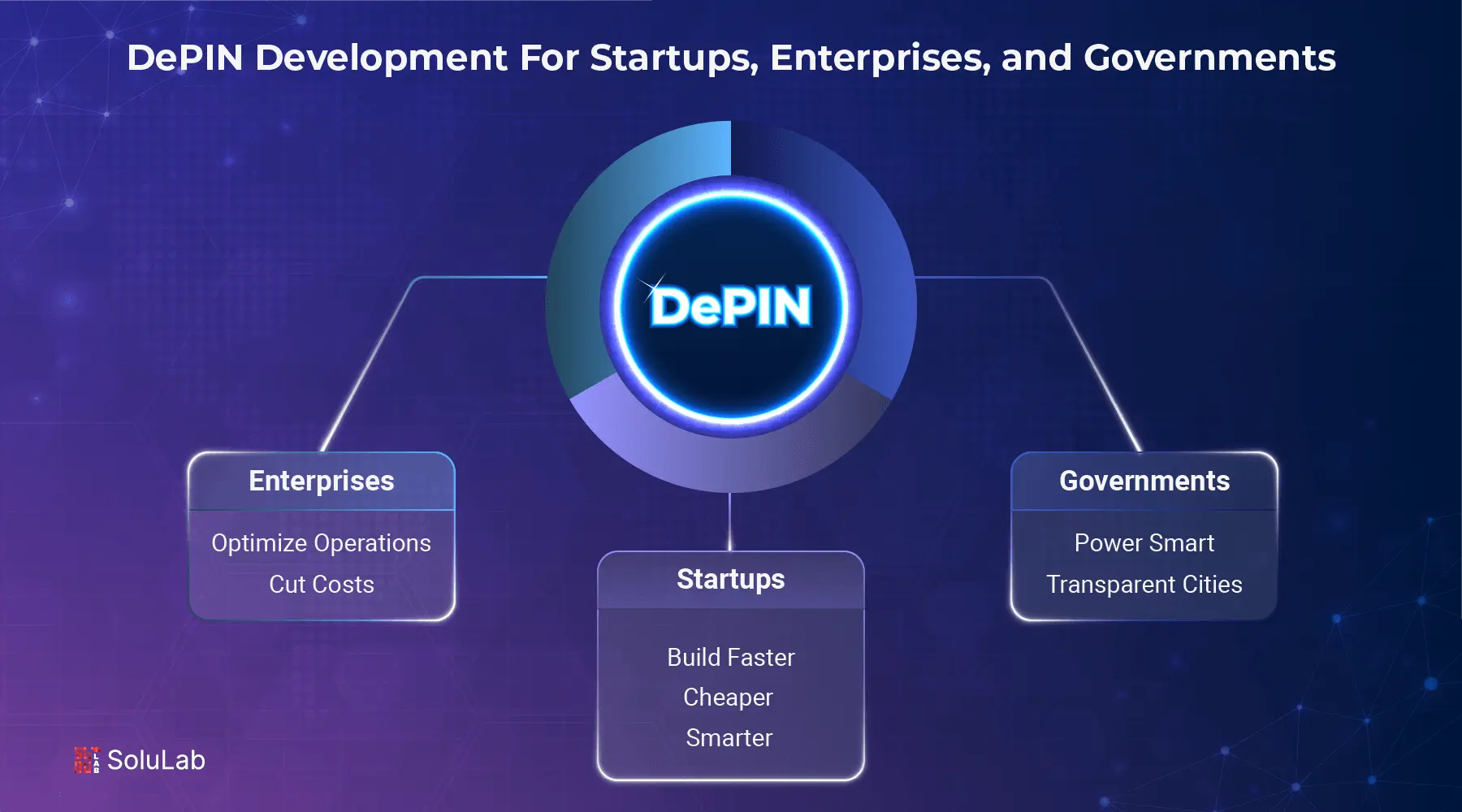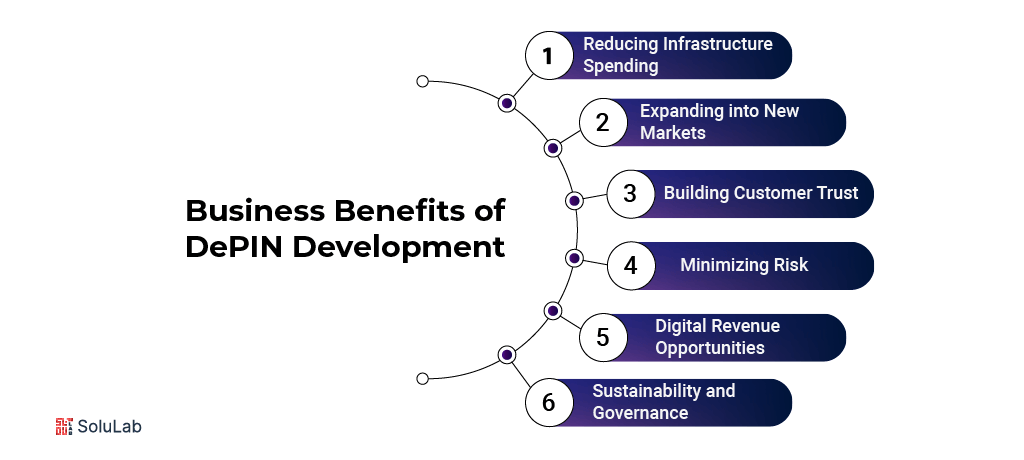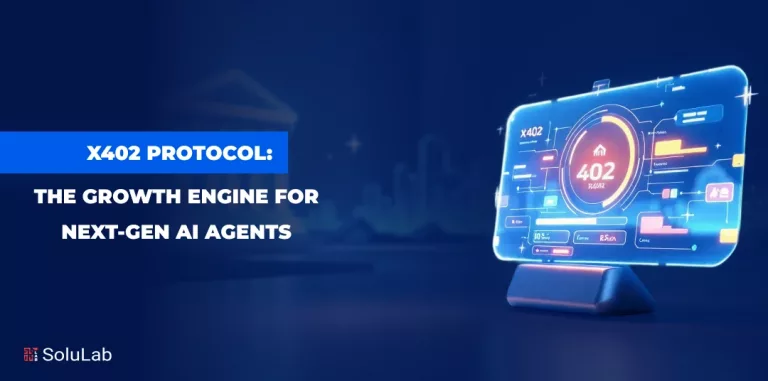
Decentralized infrastructure is opening up new possibilities in a number of industries, and companies are starting to take notice. Startups, businesses, and governments are increasingly exploring DePIN (Decentralized Physical Infrastructure Networks) to build more scalable, transparent, and efficient solutions.
The DePIN industry is projected to attain $3.5 trillion by 2028, indicating that decentralized models are vital to future-oriented plans.
This transition is propelled by the increasing benefits that DePIN provides – enhanced cost-effectiveness, augmented autonomy, and heightened community involvement. A new McKinsey survey indicates that 45% of company executives choose decentralized solutions to enhance smarter, more sustainable operations. Emerging opportunities are arising to construct infrastructure that is both dynamic and robust, ranging from decentralized wireless networks to shared energy systems.
Governments are also adopting the potential of decentralized systems to enhance contemporary infrastructure projects. The World Economic Forum indicates that 70% of smart city initiatives initiated post-2023 have used decentralized frameworks to augment innovation and community engagement. The ongoing DePIN development is fostering a future characterized by cooperation, transparency, and collective advancement.
In this blog, we take a closer look at how DePIN is reshaping opportunities for startups, businesses, and governments. As DePIN for startups continues to gain momentum, it’s opening new paths for innovation, growth, and collaboration.
Why Startups are Embracing DePIN?
Startups are now turning more and more towards DePIN (Decentralized Physical Infrastructure Networks) since it empowers them to build, grow, and innovate without the old constraints of centralized infrastructure. With speed, trust, and adaptability being the success drivers in a market, DePIN presents a new ground for startups to develop more robust and community-based solutions. Partnering with an experienced DePIN development company often becomes a strategic move, allowing these startups to tap into decentralized models efficiently and future-proof their growth.
Here are some reasons why startups are using DePIN technology:
- Lower Barriers to Entry: DePIN allows startups to access and build infrastructure without the heavy upfront costs typically associated with physical assets. Instead of owning everything, they can tap into decentralized networks, making it easier and faster to launch new services or platforms.
- Faster Market Expansion: By taking advantage of decentralized infrastructure, companies can scale their operations to new markets without the need to establish conventional facilities. This ease makes it easy to pilot markets, reach worldwide audiences, and fine-tune services according to real-world needs.
- Enhanced Transparency and Trust: Today’s users are more aware of how their data and resources are managed. DePIN models offer visible, verifiable systems where ownership and participation are clear, helping startups earn early trust and stand out in competitive markets.
- Community-Driven Growth: Startups using DePIN frameworks can invite users to become stakeholders. Not only does this method ease funding and sharing resources, but it also creates greater loyalty and commitment, making users organically brand champions.
- Access to Alternative Funding Models: Aside from conventional venture capital, startups are able to raise money through tokenized incentives, crowdsourcing, and decentralized governance systems. This makes it easier to align financial interests with community growth from the very beginning.
- Built-In Resilience: Decentralized networks minimize the risk of single points of failure. For startups, this translates to fewer interruptions, improved uptime, and more resilient operational continuity, even as they scale fast and encounter volatile challenges.
- Opportunities for Innovation: DePIN doesn’t just replicate traditional systems — it creates entirely new models. Startups working with decentralized networks often find new ways to deliver value, whether through token economies, shared resource marketplaces, or peer-to-peer infrastructure systems.
Why Enterprises and Traditional Businesses are Adopting DePIN?
For decades, large businesses and traditional enterprises have relied on centralized systems to manage everything from supply chains to customer operations. It worked — for a time. But today, things are shifting. The pace of technology, rising security risks, and changing customer expectations are pushing companies to rethink how they build and run their infrastructure. That’s where DePIN, or Decentralized Physical Infrastructure Networks, is starting to make a real difference. It’s not just another tech buzzword; it’s becoming a serious strategy for companies that want to stay competitive, scale smarter, and build systems that last.
Here’s a closer look at why DePIN is becoming part of enterprise playbooks:
1. Reducing Operational Costs
Running large centralized systems isn’t cheap — maintaining servers, managing security, scaling data centers — the costs stack up fast. With DePIN, businesses can tap into shared, decentralized networks. It means spreading the load, reducing upfront investments, and trimming ongoing operational costs without losing control.
2. Stronger Security and More Resilience
Centralized setups often have a weak spot — one breach, one outage, and everything can grind to a halt. DePIN changes that. By distributing infrastructure across many nodes, businesses build systems that can survive attacks, hardware failures, or even localized disasters without skipping a beat.
3. Boosting Transparency and Customer Trust
Trust is harder to earn and easier to lose than ever before. DePIN frameworks create transparent, tamper-proof records that customers, partners, and regulators can verify independently. For sectors like finance, healthcare, or supply chain, that kind of trust isn’t just nice to have — it’s critical.
4. Faster and Easier Market Expansion
Traditionally, expanding into a new market meant massive infrastructure investment. DePIN makes it easier. Companies can plug into decentralized infrastructure already operating locally, roll out services faster, and adjust on the fly, without the long timelines and heavy costs they used to face.
5. New Ways to Deliver Value
DePIN doesn’t just optimize old systems, it opens the door to completely new business models. We’re seeing enterprises launch decentralized identity services, loyalty programs powered by token economies, and peer-to-peer marketplaces that wouldn’t have been practical before.
6. Better, More Dynamic Partnerships
In a decentralized model, partnerships aren’t limited to two companies signing a contract. DePIN ecosystems allow multiple stakeholders, vendors, customers, and even competitors to participate, share value, and innovate together. It’s collaboration at a different level.
7. Positioning for Long-Term Success
Enterprises that move early on DePIN aren’t just fixing today’s problems, they’re setting themselves up for a more adaptable, future-proof foundation. Whether it’s scaling faster, handling future tech shifts, or responding to regulatory changes, a decentralized backbone puts them ahead of the curve.
Government and Public Sector Involvement in DePIN
Across the world, governments and public sector organizations are beginning to take decentralized infrastructure seriously. They are no longer just watching from the sidelines — many are now actively piloting or adopting DePIN to make their systems more resilient, cost-effective, and citizen-friendly. With growing interest around DePIN use cases, public bodies are seeing that decentralized models offer practical solutions to challenges that centralized infrastructure simply can’t solve anymore.
Here’s how the public sector is starting to put DePIN into action:
- Building Smarter Cities: Urban centers are under constant pressure to deliver better services with fewer resources. Governments are turning to DePIN to create decentralized energy grids, public Wi-Fi networks, and smarter transport systems, giving communities more direct access to essential services without depending on a few centralized providers.
- Modernizing Identity Systems: A number of governments are experimenting with decentralized digital identity frameworks. Instead of relying on central databases vulnerable to breaches, DePIN models give individuals more control over their information while still meeting national security and compliance standards.
- Redesigning Energy Networks: Energy independence has become a major focus. Through custom DePIN solutions, local and regional authorities are working on decentralized renewable energy grids, where citizens can generate, trade, and consume clean energy within their own neighborhoods.
- Strengthening Disaster Response: When natural disasters strike, centralized infrastructure often fails. Some governments are testing decentralized communication systems and emergency service networks that can stay functional even when parts of a city lose power or internet access.
- Increasing Transparency in Procurement: Corruption and inefficiency in government procurement are long-standing problems. With decentralized ledgers and smart contracts, agencies are finding new ways to make bidding, contracting, and public spending more transparent and accountable.
- Promoting Citizen Participation: Instead of being passive recipients, citizens are becoming active stakeholders in infrastructure projects. DePIN models allow for shared ownership, more community-driven innovation, and a greater sense of participation in public service delivery.
- Protecting Critical Systems: Cybersecurity threats are pushing governments to rethink how they secure vital systems. Decentralized models are offering a stronger, more resilient approach by spreading risk across nodes rather than concentrating it in one place.
Business Benefits of DePIN Development

Decentralized Physical Infrastructure Network is no longer just a concept discussed by blockchain enthusiasts. It’s becoming a serious tool for businesses looking to rethink how they manage operations, engage users, and scale infrastructure without the traditional bottlenecks. Companies that invest early in decentralized physical infrastructure network solutions are positioning themselves for a future where transparency, resilience, and flexibility are essential, not optional.
Here’s why businesses of all sizes are starting to look seriously at DePIN:
- Reducing Infrastructure Spending Without Compromising Growth
Traditional infrastructure demands huge capital for building, maintaining, and upgrading, and those costs only rise as companies scale. DePIN offers a way to share resources across a distributed network, helping businesses control costs without sacrificing performance or reach. - Expanding into New Markets with Greater Agility
Because DePIN solutions are decentralized, businesses aren’t tied to fixed locations or rigid rollout schedules. They can enter new markets quickly, adapt offerings to local needs, and scale operations on demand, something traditional models struggle to support. - Building Customer Trust Through Verifiable Systems
In decentralized environments, service records and transactions can be independently verified. This transparency strengthens trust with customers, partners, and regulators, a competitive edge in industries where credibility is everything. - Minimizing Risk Through Distributed Infrastructure
Rather than concentrating systems in one vulnerable location, DePIN spreads operations across many nodes. That structure helps businesses stay operational even in the face of technical failures, cyberattacks, or localized disruptions. - Unlocking New Digital Revenue Opportunities
DePIN models create space for new services like shared asset platforms, decentralized marketplaces, and token-based incentive systems. Companies can innovate faster and capture value in emerging digital economies. - Meeting Sustainability and Governance Expectations
As ESG initiatives become more central to business strategy, decentralized infrastructure offers meaningful advantages. Shared networks can reduce environmental impact, promote digital inclusion, and support more ethical technology deployment.
That’s why working with a trusted DePIN development company in the USA can make a real difference. The right partner doesn’t just deliver technical solutions; they help build infrastructure that grows with the business, adapts to the market, and stands the test of time.
Read Also: DePIN In the Telecom Industry
Future Trends in DePIN Development
The world of DePIN (Decentralized Physical Infrastructure Networks) is still taking shape, but one thing is clear: it’s evolving fast. What started as a niche idea is now becoming a serious foundation for how industries might build and operate in the coming years. As adoption grows, both startups and enterprises are finding new ways to unlock the value of decentralized systems. Whether it’s about reducing costs, creating more resilient infrastructure, or building communities around shared ownership, the next wave of DePIN development will look very different from what we see today. The role of DePIN for startups is expected to be especially important, as early movers continue to drive innovation and reshape industries from the ground up.
Here are some of the key trends shaping the future of DePIN:
1. Specialized Networks Focused on Specific Industries
Instead of broad, generalized platforms, we’ll see DePIN networks designed to meet the unique needs of industries like supply chain, healthcare, energy, and transportation. Focused networks will allow for faster innovation and better performance by addressing very specific challenges.
2. Cross-Network Interoperability
As more decentralized systems launch, the need for them to communicate and share resources will grow. Future DePIN platforms will focus on interoperability, making it easier for businesses and users to move assets and data across different decentralized environments without friction.
Read Also: Blockchain Interoperability for Enterprise Adoption
3. Community-Owned Infrastructure Models
Ownership is shifting away from corporations and moving toward communities. Many future DePIN projects will be built around shared ownership models, where users contribute resources and help govern the network, gaining real economic incentives for their participation.
4. DePIN as a Backbone for Startups
Early-stage companies are already seeing the benefits of building on decentralized networks. Going forward, DePIN models will offer startups faster routes to market, lower operational costs, and the ability to create entirely new service categories that weren’t possible with traditional centralized models.
5. More Clarity Around Regulation
Governments and regulatory bodies are starting to pay closer attention to DePIN. We’ll likely see the creation of regulatory frameworks designed to support secure, resilient decentralized infrastructure without stifling innovation or community ownership.
6. Integration of AI and Machine Learning
Intelligent DePIN networks are coming. AI-driven management and optimization of decentralized infrastructure will make these systems more efficient, self-healing, and capable of making real-time adjustments based on network conditions.
The Bottom Line
The rise of DePIN marks a major shift in how businesses, governments, and communities approach infrastructure. Instead of relying solely on centralized systems, organizations are embracing decentralized models that offer greater flexibility, transparency, and resilience. From startups to enterprises, the movement toward DePIN is opening new pathways for growth, innovation, and collaboration across industries.
At SoluLab, we have been at the forefront of delivering real-world decentralized solutions. Our work with Morpheus.Network, a blockchain-powered SaaS platform designed to streamline and secure global logistics, is a strong example of how DePIN models are already reshaping traditional industries. Morpheus.Network brings together blockchain, IoT, SMS notifications, and legacy technologies to create smarter, more secure supply chains. Through projects like this, SoluLab continues to build DePIN solutions that bridge the gap between emerging tech and existing business ecosystems, helping our clients lead confidently into a decentralized future.
If you’re exploring how DePIN could transform your business, now is the time to act. Connect with SoluLab today to learn how we can help you build decentralized systems that are practical, scalable, and ready for what’s next.
FAQs
1. What industries can benefit the most from DePIN solutions?
DePIN solutions aren’t limited to any one sector. Industries like supply chain management, energy distribution, telecommunications, healthcare, and even agriculture are already seeing value. Anywhere that infrastructure needs to be more resilient, transparent, or distributed, DePIN can create opportunities to rethink the way services are delivered and managed.
2. How is DePIN different from traditional blockchain networks?
While traditional blockchain networks often focus on financial transactions or digital assets, DePIN is about connecting physical infrastructure — things like data centers, wireless networks, or energy grids — through decentralized coordination. It’s about linking the physical and digital worlds in a way that removes centralized control and distributes both responsibility and benefit more evenly across participants.
3. Is DePIN development only suitable for startups and tech companies?
Not at all. While startups are quick to adopt DePIN because of its flexibility, larger enterprises and even public sector organizations are exploring DePIN to modernize infrastructure, reduce operational costs, and offer new services. It’s not about company size — it’s about how willing an organization is to adapt to more open, decentralized models.
4. What skills and technologies are needed to build a DePIN network?
Developing a strong DePIN network typically requires expertise in blockchain architecture, IoT integration, cybersecurity, and decentralized governance models. It’s not just about coding; it’s about designing systems that can function independently, stay secure, and scale over time without relying on central points of control.
5. How can companies future-proof their investment in DePIN technology?
The smartest approach is to design systems that are flexible and adaptable from day one. Rather than locking into a single platform or standard, businesses should focus on open architectures, interoperability, and community-driven governance models. It’s also critical to stay engaged with the evolving DePIN ecosystem, as the technology, standards, and best practices will continue to mature over the next few years.






